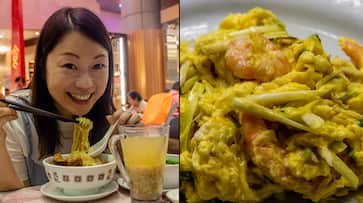Hong Kong has emerged as a centre of international trade - implies that there are all variations of gourmet offerings on tap. French and Vietnamese diners rub shoulders with Lebanese eating-houses.
I woke up feeling exceedingly hungry. That’s what knowing that I’m heading to Hong Kong, always does to me. The place has to its legacy - a reputation for traditional Cantonese cuisine, centuries-old teahouses, and foods with distinctive influences from the city’s British past. In more recent times, odes have been penned to the litany of international chefs who’ve arrived here, whipping up an innovative fare.

Since Dim Sum or bite-sized portions of food - is the welcome mat to most meals in these parts, I begin my quest at Dragon-I, the Dim Sum brunch place on Lan Kawai Fong at which locals vote with their feet. The plates arrive in a relentless assault. Steamed shrimp dumplings. Pan-fried turnip cakes. Stir-fried kale. Tuna rolls. The accompanying sauces are so good; you want to lick them off your fingers. The pregnant woman’s fried rice - made with asparagus, dried shrimps, scallion, soy sauce and moderate amounts of ginger (apparently good for pregnant women), seals the deal on the place’s reputation.

In relentless pursuit of other local food treats, I head to Lan Fong Yuen, an eatery that’s been around since 1953. Wear the pants with the elastic waistband, if you want to do justice to a feast of the classic Hong Kong milk tea, pork chop bun and condensed-milk butter bun. You can taste the influence of British culture in the local love for afternoon black tea with milk, but the Hong Kong version comes with its own twist - tea with evaporated milk (or unsweetened condensed milk) and sugar. This tea is known locally as pantyhose tea, as it comes strained through a material, not unlike the fabric used for stockings.
The camaraderie convened at Lan Fong Yuen, means I’m soon pointed in the direction of other local gems; and I scurry to the Tai Cheong Bakery, to sample traditional egg tarts at a store that used to be popular with Hong Kong’s last colonial governor - Chris Patten.
To break up this nose-to-tail eating, a tea appreciation workshop at the Ming Cha Tea house, is next on the cards. The workshop over endless cups of carefully-brewed tea, explores the manner in which one learns to create a perfect cuppa, and recognize the distinctive aromas, tastes and after-tastes of the brew set before you.
I’m encouraged to dissect my thoughts on Jasmine Blossom Tea, White Peony Supreme, Phoenix Osmanthus - for instance, on the basis of aroma, body and aftertaste. Each beverage has its unique properties. White Peony does wonders when it comes to cooling internal body heat, while Phoenix Osmanthus lowers blood cholesterol. If you want more tea education, the Li-Nong Tea House on Lantau Island, is also a good place to witness a traditional tea ceremony.

In a society where eating out in particular, and food in general, plays a significant role, one is never too far from a place to dine. I punctuate my visit to the Langham Palace, a commercial complex and shopping centre, with a visit to the Food Court. At Langham Chee Kai, the fish ball soup, wonton over braised noodles, and the assorted meat congee Canton style satisfy. The flavours are robust, the servings generous, the meal good-value – a common denominator to most dining experiences in these parts.

Another staple in a place that lives by water is seafood. Spending a few days like paparazzi on the trail of a young starlet, in pursuit of the city’s freshest seafood, is next on my agenda. I relish a seafood-filled hot-pot at Glasshouse – which in its own words, is an Asian cuisine restaurant with a Western twist. Lobster and clam at the Rainbow Seafood restaurant, where I’m required to select from a tank, the fish that I’d like to sample. Bringing the live creature to your table to confirm its freshness, is not uncommon in these parts.
But to eat fish right by the waters from which it’s caught heightens the experience. The fishing village at Tai’O, once an important trading (exporting salt from its salt pans) and fishing port, on the West Coast of Lantau Island, is the perfect case in point. As I walk along the streets, past stilt houses that retain the area’s historical character, all permutations and combinations of fishy treats hang out before me. Here dried seafood. There salted fish. Everywhere, shrimp paste. Cantonese cuisine does a whoppingly good XO sauce - a seafood-based condiment that will have you licking your fingers with glee.

I settle myself at the Lin Heung Tea House. Furnished with basic tables and chairs, it’s rather nondescript atmospherically; but there’s something to be said about eliminating plate poetry and concentrating solely on the food at hand. I settle down with a plate of oysters - slimy, pert and singing with flavour, followed by a satisfying plate of fried shrimp served with egg and noodles, all washed down with a local beer.
That Hong Kong has emerged as a centre of international trade - implies that there are all variations of gourmet offerings on tap. French and Vietnamese diners rub shoulders with Lebanese eating-houses. Speciality restaurants, given to innovation and fusion, are also constantly blossoming. I visit Grassroots Pantry, to which lovers of fine-vegetarian fare flock. Here I try whimsical raw, spicy, mock-tuna hand-rolls, kelp & mung bean noodle salad, teff shitake gnocchi and nut-butter chocolate fondant - amid a host of other experimental offerings.

But the experience that I savour most unfolds at the Kung Lee Herbal Tea shop. Here I learn that at a time before TV, it would be to these teahouses that people flocked. They came not just for a spot of camaraderie, but also for the herbal teas on offer - thought to treat everything from an excess of body heat, to acne. In Kung Lee, I’m transported to the 1960’s. I admire the wooden fixtures and traditional ceiling tiles, relish the sugarcane juice and herbal tonics, think with fondness of the barley biscuits and ginger candy (that have been available since the 1920’s at Chan Yee Jai) in my shopping bag. But most of all, I appreciate the fact that - despite the whimsical caprices of style and changing taste, Hong Kong has retained with as much pride, its traditional culinary worlds.
Fact File
Getting There – There are several direct flight options between Delhi and Hong Kong.
Staying There – Lan Kwai Fong - If staying in an atmospheric boutique hotel - that’s also centrally-located - means anything to you, then this one ticks all the boxes. For more information, visit lankwaifonghotel.com.hk
Last Updated Sep 19, 2018, 12:14 PM IST









![Salman Khan sets stage on fire for Anant Ambani, Radhika Merchant pre-wedding festivities [WATCH] ATG](https://static-gi.asianetnews.com/images/01hr1hh8y86gvb4kbqgnyhc0w0/whatsapp-image-2024-03-03-at-12-24-37-pm_100x60xt.jpg)
![Pregnant Deepika Padukone dances with Ranveer Singh at Anant Ambani, Radhika Merchant pre-wedding bash [WATCH] ATG](https://static-gi.asianetnews.com/images/01hr1ffyd3nzqzgm6ba0k87vr8/whatsapp-image-2024-03-03-at-11-45-35-am_100x60xt.jpg)


